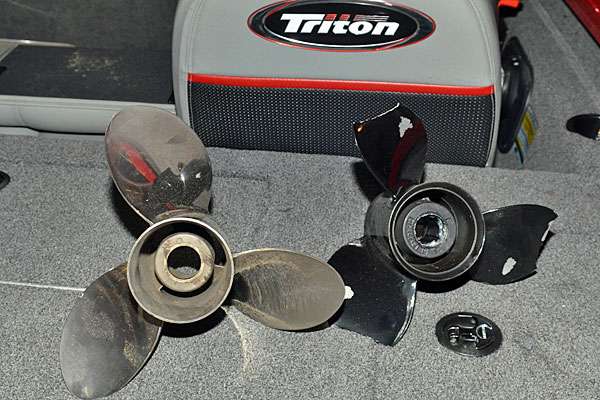
To see photos of the test, click here.
In the first part of this three-part series, we talked about load and weight distribution. The high points: First, you don’t need to carry 106 lipless cranks. Try 15. Second, how your gear is distributed throughout your boat is paramount to performance, both hole shot and all-out speed. In general, keep terminal tackle, bulk plastics and heavy items in the rear for best performance unless you need to pop up on plane in a hurry (like in shallow water), then put these items up front. The second part was about jackplates. Now, once you’ve got your gear squared away and a fancy new plate, let’s talk about another way to get your tin rig running its best: selecting the right propeller.
For this installment, our test mules were a 2008 Bass Tracker Pro Team 190 with a 90-horse Mercury Optimax (www.trackerboats.com) that belongs to B.A.S.S. Tournament Manager Chuck Harbin. If you’ve ever been to a Bassmaster Elite Series event or fished a Bass Pro Shops Bassmaster Open, chances are you’ve seen Chuck around. He’s had the boat for several years and is pleased with it, but like all boat owners, he’d like a little more from it, and he got it with a certain combo. We also had the same 2013 Triton X18 with a 115-horse Mercury Optimax ProXS that belong to yours truly, the author. I got this boat new last year and, without sounding like a salesman, have been bowled over at how it runs and fishes. Check out the dimensions for yourself (www.tritonboats.com). We also had several stainless props on hand. The Triton needed a new prop, as you’ll see in the photo gallery. (The logs on the Coosa River are a mean breed, especially when it comes to aluminum props.) The Tracker showed up with a 20-pitch (20P) Mercury Laser II prop, the go-to for many small-HP Merc owners. The Triton sported a 21P aluminum that was missing the tips of all three ears. On hand we had a 22P Mercury Laser II, and a generic 21P stainless.
Naturally, we want the most from our boats in terms of hole shot, top end speed and cruising comfort. But, like regearing a car, tradeoffs abound and there is no such thing as the perfect prop for all of these. You can opt for a prop that gives you a better top end, but it won’t pop out of the hole like you’d like. Conversely, you can use a prop that has the boat seemingly sitting on pad at all times, but you’ll likely not hit that high MPH mark you did with the other prop. Pick which performance characteristic is most important to you and choose accordingly. However, one caveat for all propeller testing: have an honest-to-goodness load in your boat for the most accurate results. For example, don’t take everything out just to see a new high MPH mark when testing. When you put your tackle and a co-angler in, your boat will perform wildly different. Now then, let’s get started. The testing took place on Lake Mitchell, a Coosa River impoundment in central Alabama on a warmish day this past February.
Tracker Pro Team 190
Baseline numbers for the 18’ 7”, 89-inch beam, 1,041-pound Tracker with the 20P stainless Laser II were 42 MPH with the motor bouncing off the rev limiter at nearly 6,000 RPM. The fact that the motor wanted to over-rev was proof enough that this rig needed at less tall (higher pitch number) prop. First, we stuck the 21P on Harbin’s Tracker and he let it loose. The result? The same hole shot, and a little bit of a wobble when it topped out at 45.2 MPH @ 5,800 on the GPS. That’s a 3-plus MPH gain. With the 22P, he noted a 44.5 MPH top speed and better handling at higher speeds. Plus his RPMs are where they need to be, in the 5,700 RPM range. Harbin decided to go with the 22P for the slightly lower RPM range, better handling and basically same top speed as the 21P.
Triton X18
The 18’ 8”, 92-inch beam 1,180-pound hull Triton ran 50.1 MPH before the aluminum 21P got mangled and before a 6-inch T-H Marine Z-Lock jackplate was added and the motor was raised 1 inch (check your warranty to see if such accessories void it). Naturally, I went with a stainless 21P and expected more or less the same performance. Wrong. The stainless came out of the hole like a zombie climbing from the grave, but offered better handling and a better top end (51.2), likely thanks to the plate as well. Turns out the flex and aluminum prop gives will pop the boat up better from the hole. But, your top end will suffer as an aluminum prop will bend and hold a less-true pitch at high RPM. Oddly enough, the 21 wanted to overrev with a light load (just me and my gear) and was on target with a partner (heavy load). I usually fish solo — unless you count my dog — so I needed just a little less prop and put the 22P Laser II on. Alas, the hole shot was better, but not like it was with the 21, and Daisy dog and I saw 53.5 MPH on the Raymarine GPS at 5,750 RPM. Perfect. Flip through the photo gallery to see images from the test day.




